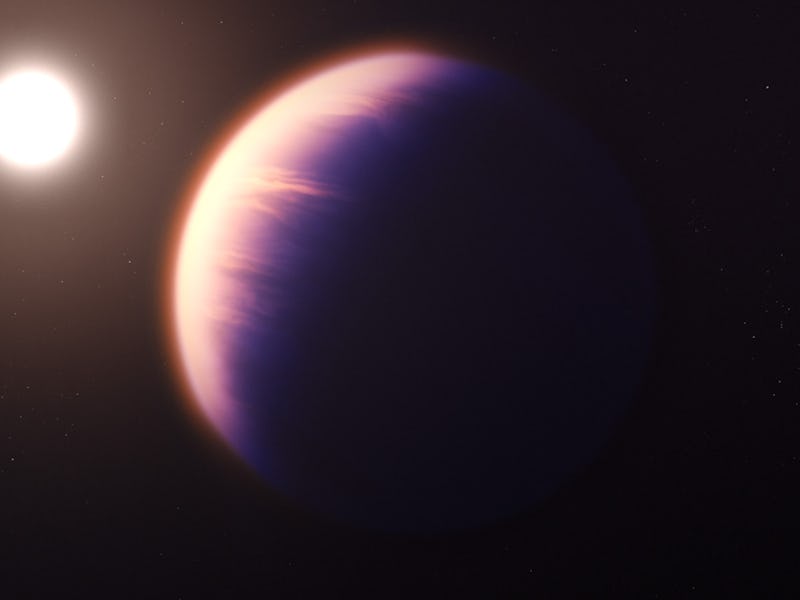Webb Telescope finds carbon dioxide in a hot Jupiter atmosphere — with hopes for smaller planets down the line
While the planet is too large and hot for life, it could help us study more Earth-like exoplanets.

Just a few years ago, astronomers were lucky if they could even find vague ghosts of planets in other star systems. Today, astronomers haven’t just found thousands of exoplanets — they’re starting to peel away their atmospheres and find the chemicals that lie within.
Now, for the first time, astronomers have found a telltale sign of carbon dioxide above a gas giant in another star system. The discovery comes thanks to the James Webb Space Telescope (JWST), which has enabled astronomers to peer into distant skies with a resolution better than any telescope before.
It’s an exciting result on its own. It’s also something of a dress rehearsal that JWST could see the same on smaller, more Earth-like planets.
The carbon dioxide signal coming from Webb appeared unambiguous.
What’s new — The planet at hand (or in lens, as it were) is a gas giant named WASP-39b. As WASP-39b transited in front of its star from our perspective, some of that star’s light glanced through the planet’s atmosphere. In the process, the component’s blocked out certain wavelengths of that distant starlight’s electromagnetic spectrum. Different chemicals etched different “fingerprints” into the spectrum.
Astronomers from Earth can play celestial forensic scientists: They can examine those fingerprints and reconstruct what chemicals caused them. It’s a type of measurement called spectroscopy. JWST has an instrument called NIRSpec designed to do just that.
In WASP-39b’s case, astronomers found spectral signatures in the part of the electromagnetic spectrum with wavelengths between 4.1 to 4.6 microns [4100 to 4600 nanometers], which is deep in the infrared. These blips indicate a clear carbon dioxide signature.
Here’s the background — WASP-39b lies about 700 light-years from Earth, out in the direction of the constellation Virgo. WASP-39b is a gas giant, about a quarter of Jupiter’s mass, but even bigger than Jupiter’s radius. It orbits very close to its host star: about one-twentieth the distance between Earth and our Sun.
Astronomers can count their lucky stars that WASP-39b’s orbit is aligned in a way that lets us see it edge-on. The planet’s size and close distance to its star, then, mean that when the planet does cross in front of its sun, it blots out enough light to slightly dim the star. Our instruments can notice that subtle drop.
It’s a common way of finding exoplanets, especially large ones. It was exactly how astronomers found WASP-39b in 2011. The name comes from the Wide Angle Search for Planets (WASP), the sky survey astronomers used to find it.
The way WASP-39b was discovered also means that the world is a ripe target for us to scout its atmosphere. JWST’s pass at the planet wasn’t astronomers’ first attempt at observing WASP-39’s atmosphere. In 2018, scientists using NASA’s Hubble and Spitzer telescopes found traces of water vapor on the planet.
WASP-39b wasn’t directly imaged. Rather, the planet passes in front of the star, causing a perceptible dip in its light.
Why it matters — Astronomers have observed other gases, like methane and water vapor, in exoplanets’ atmospheres. But carbon dioxide has proven trickier to find — until now.
JWST can investigate with far better resolution than any telescope could before. Scientists didn’t hesitate to sing its resolution’s praises. “Seeing the data for the first time was like reading a poem in its entirety, when before we only had every third word,” said Laura Kreidberg of the Max Planck Institute for Astronomy in Germany.
While there are a myriad reasons that carbon dioxide can enter an atmosphere—from biological activity to chemical processes in rock to an industrial civilization—there are a few things scientists can learn from its presence. By measuring carbon dioxide in a gas giant’s atmosphere, astronomers can learn how much gaseous material (as opposed to solid material) went into forming the planet.
What’s next — Some of JWST’s mission goals revolve around exoplanets. Scientists hope to use the telescope to better understand how exoplanets form, what exoplanets look like—and what life they might develop.
WASP-39b isn’t really a target for finding life. Not only is it a gas giant, its closeness to its star means that it simmers at a boiling 900 degrees Celsius [1650 degrees Fahrenheit]. But the list of Earth-sized worlds at cooler distances continues to grow. This discovery, then, is a good omen that the telescope has the potential to do the same measurements with their atmospheres, should they exist.
“Detecting such a clear signal of carbon dioxide on WASP-39b bodes well for the detection of atmospheres on smaller, terrestrial-sized planets,” said Natalie Batalha, an astronomer at the University of California at Santa Cruz in a press statement.
Don’t be surprised if more exoplanet-related discoveries follow in quick succession in coming months. This discovery came from what JWST’s minders are calling the Early Release Science program, intended to drop JWST’s findings into the hands of exoplanet-hunters as soon as possible. It’s clear that astronomers have barely scratched the surface (or the atmosphere, as it were) of what JWST can see.